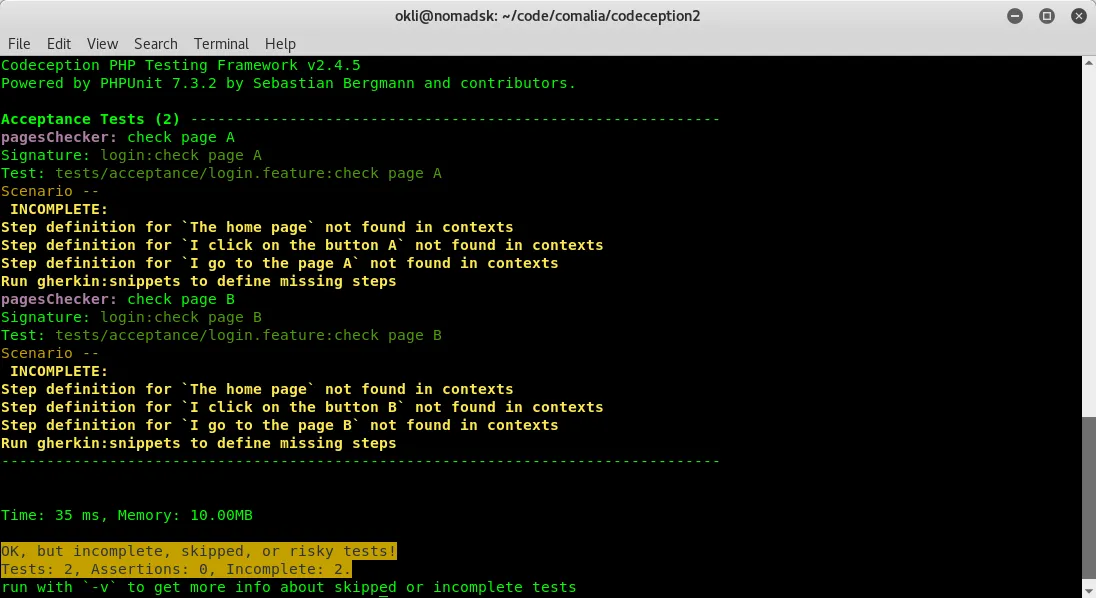我正在寻找一个简单的代码示例,使用pageObject设计模式和gherkin语言,因为当我按照codeception BDD文档中的示例编写测试时,所有的示例都写在tests/support/AcceptanceTester.php文件中,我不明白(英语能力差- -)如何不把所有的代码都集中在AcceptanceTester.php文件中。
例如,我有一个带有两个按钮A和B的示例主页。如果用户点击按钮A,则加载页面A,否则如果用户点击按钮B,则加载页面B。
目前,我的AcceptanceTester:
如果我运行命令'./vendor/bin/codecept run acceptance',一切都很顺利。但是正如我之前所说的,我需要学习如何不将所有代码集中在AcceptanceTester文件中。
因此,我创建了三个页面对象;一个用于主页,一个用于A页面,一个用于B页面。 代码:
主页对象:
{{A页面对象}}:
然后,我创建了三个步骤对象:homeChecker、goToPageA和goToPageB。 homeChecker步骤对象:
例如,我有一个带有两个按钮A和B的示例主页。如果用户点击按钮A,则加载页面A,否则如果用户点击按钮B,则加载页面B。
目前,我的AcceptanceTester:
<?php
// tests/_support/AcceptanceTester.php
/**
* Inherited Methods
* @method void wantToTest($text)
* @method void wantTo($text)
* @method void execute($callable)
* @method void expectTo($prediction)
* @method void expect($prediction)
* @method void amGoingTo($argumentation)
* @method void am($role)
* @method void lookForwardTo($achieveValue)
* @method void comment($description)
* @method \Codeception\Lib\Friend haveFriend($name, $actorClass = NULL)
*
* @SuppressWarnings(PHPMD)
*/
class AcceptanceTester extends \Codeception\Actor
{
use _generated\AcceptanceTesterActions;
/**
* @Given The home page
*/
public function inHomePage()
{
$this->amOnPage("/");
$this->seeInTitle('home');
}
/**
* @When I click on the button A
*/
public function goToThePageA()
{
$this->click(['name' => 'A']);
}
/**
* @Then l go to the page A
*/
public function ImInPageA()
{
$this->seeInTitle('page A');
}
/**
* @When I click on the button B
*/
public function goToThePageB()
{
$this->click(['name' => 'B']);
}
/**
* @Then l go to the page B
*/
public function ImInPageB()
{
$this->seeInTitle('page B');
}
}
如果我运行命令'./vendor/bin/codecept run acceptance',一切都很顺利。但是正如我之前所说的,我需要学习如何不将所有代码集中在AcceptanceTester文件中。
因此,我创建了三个页面对象;一个用于主页,一个用于A页面,一个用于B页面。 代码:
主页对象:
<?php
// tests/_support/Page/PageHome.php
namespace Page;
class PageHome
{
public static $URL = '/home';
public static $title = "home";
public static $aButton = ['name' => 'A'] ;
public static $bButton = ['name' => 'B'] ;
public static function route($param){
return static::$URL.$param;
}
/**
* @var \AcceptanceTester;
*/
protected $acceptanceTester;
public function __construct(\AcceptanceTester $I){
$this->acceptanceTester = $I;
}
}
{{A页面对象}}:
<?php
// tests/_support/Page/PageA.php
namespace Page;
class PageA
{
public static $URL = '/home/pageA';
public static $title = "page A";
public static function route($param){
return static::$URL.$param;
}
/**
* @var \AcceptanceTester;
*/
protected $acceptanceTester;
public function __construct(\AcceptanceTester $I){
$this->acceptanceTester = $I;
}
}
还有B页面对象:
<?php
// tests/_support/Page/PageB.php
namespace Page;
class PageB
{
public static $URL = '/home/pageB';
public static $title = "page B";
public static function route($param){
return static::$URL.$param;
}
/**
* @var \AcceptanceTester;
*/
protected $acceptanceTester;
public function __construct(\AcceptanceTester $I){
$this->acceptanceTester = $I;
}
}
然后,我创建了三个步骤对象:homeChecker、goToPageA和goToPageB。 homeChecker步骤对象:
<?php
// tests/_support/Step/Acceptance/HomeChecker.php
namespace Step\Acceptance;
use Page\Acceotance\HomePage;
class HomeChecker extends \AcceptanceTester
{
/**
* @Given The home page
*/
public function main()
{
$homePage = new PageHome($this);
$this->amOnPage($homePage::URL);
$this->checkTitle($homePage);
$this->checkButtons($homePage);
}
private function checkTitle($homePage){
$this->seeInTitle($homePage::$title);
}
private function checkButtons($homePage){
$this->see($homePage::$aButton);
$this->see($homePage::$bButton);
}
}
PageAChecker stepObject:
<?php
// tests/_support/Step/Acceptance/PageAChecker.php
namespace Step\Acceptance;
use Page\PageHome;
use Page\PageA;
class PageAChecker extends \AcceptanceTester
{
/**
* @When I click on the button A
*/
public function clickButton()
{
$homePage = new PageHome($this);
$this->click($homePage::$aButton);
}
/**
* @Then l go to the page A
*/
public function checkTitle()
{
$aPage = new PageA($this);
$this->seeInTitle($aPage::$title);
}
}
而 PageBChecker 步骤对象:
<?php
// tests/_support/Step/Acceptance/PageBChecker.php
namespace Step\Acceptance;
use Page\PageHome;
use Page\PageB;
class PageBChecker extends \AcceptanceTester
{
/**
* @When I click on the button B
*/
public function clickButton()
{
$homePage = new PageHome($this);
$this->click($homePage::$bButton);
}
/**
* @Then l go to the page B
*/
public function checkTitle()
{
$bPage = new PageB($this);
$this->seeInTitle($bPage::$title);
}
}
现在,我不知道该做什么。如果我清空我的AcceptanceTester文件并再次运行'./vendor/bin/codecept run acceptance'命令,则测试是不完整的,并且我在shell中收到“未在上下文中找到”的警告:
我该怎么办?
更新 我在codeception的GitHub上创建了一个帖子,链接如下:
https://github.com/Codeception/Codeception/issues/5157
我描述了一个最小化的示例来重现我的问题和一个(非常)丑陋的解决方法。我希望找到一种好的方法并理解为什么我所描述的方法不起作用!

function clickButton($homePage PageHome) { $this->click($homePage::$bButton); }。 - Oliver Maksimovic